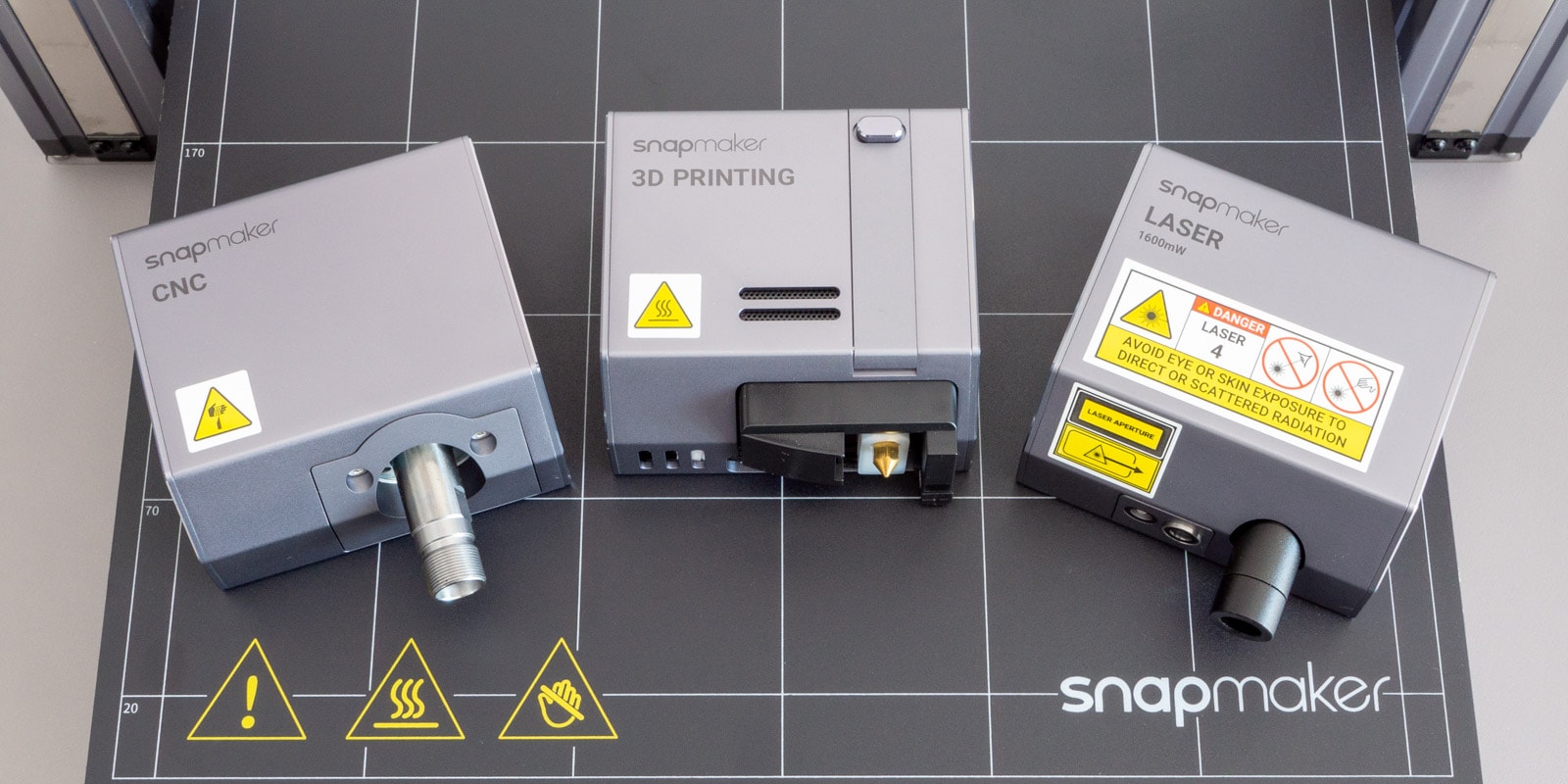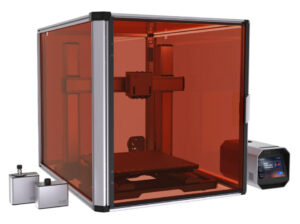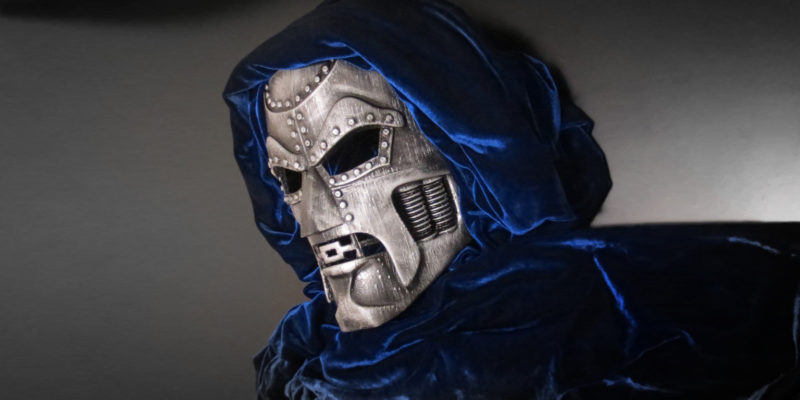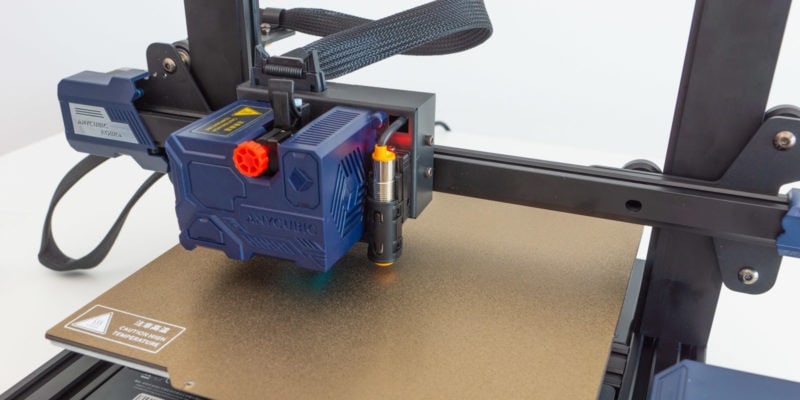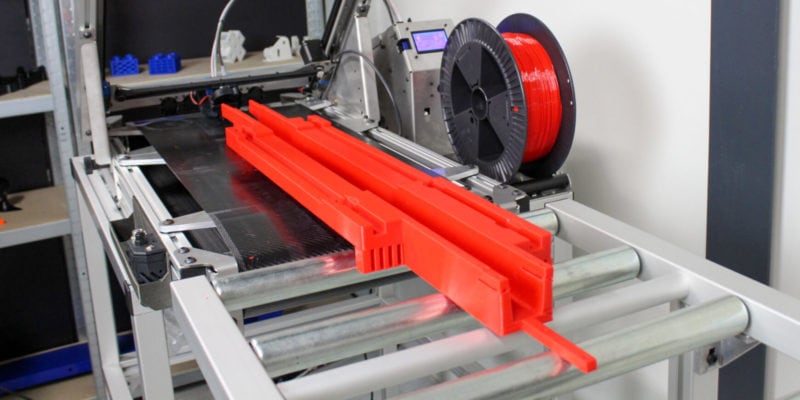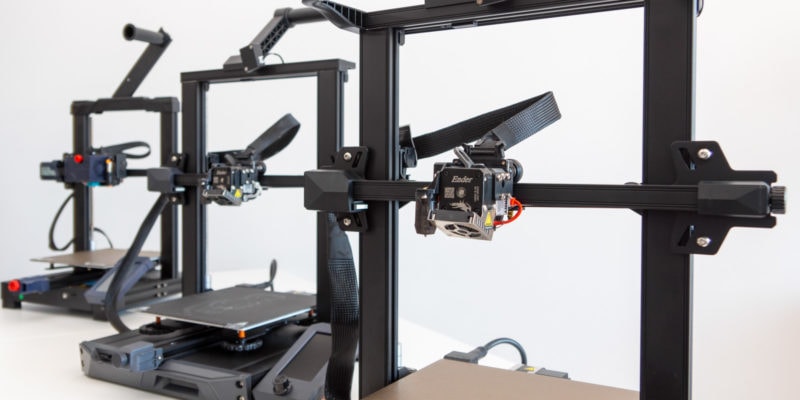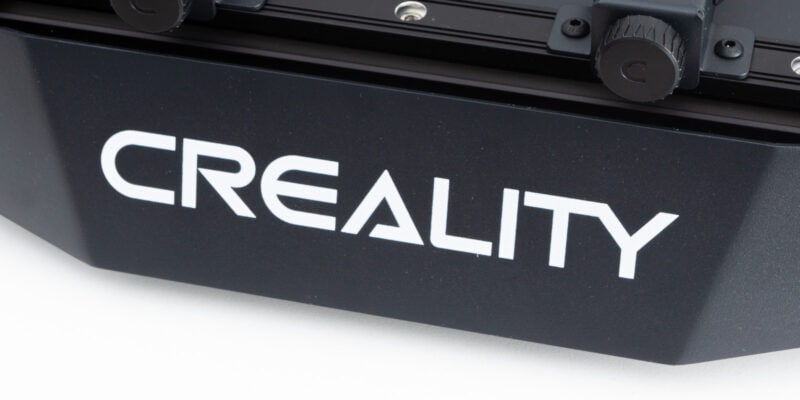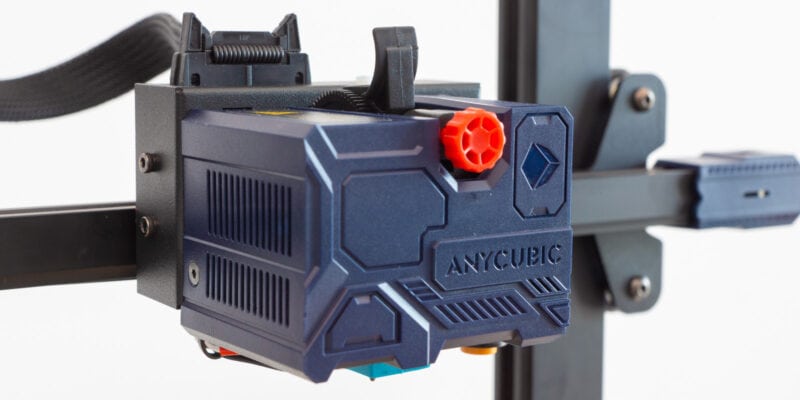3-in-1 3D printers are very much in demand due to their unique value proposition. You can 3D print using a print head, carve using a CNC bit, and engrave your models using a laser, all on a single machine. This versatility opens up several avenues for DIY makers, hobbyists, and creators who can enjoy these processes without having to purchase multiple machines.
The Snapmaker 2.0 popularized this category of multi-purpose machines. With its excellent features and solid build quality, it became the go-to 3-in-1 3D printer for many enthusiasts. But it’s not the only one in the market.
In this article, we’ve gathered a list of 3D printer / laser cutter / CNC router combo machines that are available today. We’ll go over each one’s key features and applications, and highlight the areas where they excel. By the end, you’ll know which is the best 3-in-1 3D printer that perfectly aligns with your needs.
| 3-in-1 3D Printer | Summary | Build Volume | Enclosure | Price (~) | Best Offer |
|---|---|---|---|---|---|
| Snapmaker 2.0 A350T | Best overall | 320 x 350 x 330 mm | Optional | $1599 | |
| Snapmaker Artisan | Best high-end | 400 x 400 x 400 mm | Enclosed | $2799 | |
| EcubMaker TOYDIY | Best on a budget | 180 x 180 x 180 mm | None | $699 | |
| ZMorph Fab | Best 3D printer & CNC mill | 235 x 250 x 165 mm | Enclosed | $2199 | |
| Creality CP-01 | Best Creality 3-in-1 3D printer | 200 x 200 x 200 mm | None | $602 |
Why Buy a 3-in-1 3D Printer?
3D printing is only a single facet of the rapid prototyping process. You can also use CNC milling and laser engraving and cutting to create prototypes and end-use components. So, what’s the advantage of having all these technologies in a single machine?
Desktop Space Savings
3-in-1 3D printers use your desktop space more effectively by combining all three functions in a single machine. You don’t need to buy separate machines for each process, so you save a lot of space on your workbench or 3D printer table.
Cost Savings
An all-in-one 3D printer can be more cost-efficient than purchasing three separate machines. Not only do you save on the machine’s cost, but you also eliminate the need for hosting three devices. For example, you won’t need multiple enclosures, air filters, power outlets, and so on.
Having the option to use one of the manufacturing methods, for example, CNC cutting, only once in a while can also justify the purchase of a 3-in-1 machine. In that situation, buying a separate CNC router might not be worth it.
These savings can benefit budget users, small shops, and educational institutions that do not have the space or the money to buy different devices for each process.
Ease of Use
The best 3-in-1 3D printers are designed to be easy to use. You don’t need vast technical knowledge, and the features in these machines are straightforward to configure in the accompanying software.
In addition, switching between the various machining modes is usually quick and effortless. So you can quickly get started even if you’re unfamiliar with CNC milling and laser engraving.
It should be said that not all 3-in-1 3D printers are equally easy to use, and some require more experience to operate. A lot of it depends on the software that comes with the machine, which we’ll cover in more detail later.
The Best 3D Printer / Laser Cutter / CNC Milling Combo Machines in 2024
The Snapmaker 2.0 reigns in the hobbyist level 3-in-1 3D printers category with its sleek industrial design and ease of use. The Snapmaker 2.0 features a fully modular design, and its simple plug-n-play tool heads (modules) make it easy for you to switch between its various modes.
It has three separate tool heads, one each for 3D printing, CNC milling, and laser engraving. In terms of 3D printing features, you get a direct extrusion setup with a hot end that reaches up to 275 °C. This allows you to use a wide variety of 3D printing filaments, including PLA, PETG, ABS, and other materials.
Its heated bed with an automatic bed leveling system helps you achieve reliable and consistent 3D prints. The Snapmaker 2.0 also uses an intuitive color touchscreen for its controls, which makes it easy to navigate the printer’s menus and settings.
Its laser engraver module has an inbuilt camera that autofocuses the laser on the workpiece. The 1.6W laser engraver can precisely engrave dots up to 0.2 mm and works well on paper, leather, wood, and corrugated fiberboards.
For CNC machining, the Snapmaker 2.0 comes with an ER11 collet which supports 0.5 – 6.5 mm drill bits and has a maximum spindle speed of 12,000 RPM. It’s sufficient for milling woods, acrylics, and other plastics.
There’s no option for the stock Snapmaker 2.0 with metals. For that, the laser tool head and CNC router functionality are not powerful enough. There is a 10 Watt laser module accessory available, however, that is more powerful and can engrave metals.
The Snapmaker 2.0 also comes with an optional fully enclosed build chamber that keeps the laser cutting fumes and CNC router swarf contained. It’s a pricy addition to the setup, but it does what it’s supposed to do.
On the software side, the Snapmaker 2.0 uses Snapmaker’s Luban software to tie the machine together. You can use it to prepare your files for all three different processes, without the need for any third-party software.
Considering its features, modularity, and range of accessories, the Snapmaker 2.0 is a well-rounded 3-in-1 3D printer suited for hobbyists and professionals alike. It is a great addition to any hobbyist workspace, DIY maker space, or prototyping lab that can fully utilize its multi-purpose capabilities.
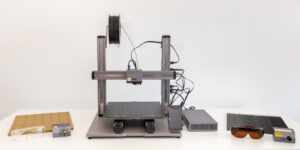
Standout Features
- Complete, well-rounded machine
- Built-in camera for laser engraver
- Solid construction
- Materials included
Technical Details |
|
|---|---|
| 3D printing build volume | 320 x 350 x 330 mm |
| Laser engraving area | 320 x 350 mm |
| CNC carving area | 320 x 350 x 275 mm |
| Max nozzle temperature | 275 °C |
| Laser power | 1600 mW |
| CNC spindle speed | 6,000 - 12,000 RPM |
| Supported materials | PLA, ABS, PETG, TPU, Wood, leather, plastic, fabric, paper |
| Connectivity | Wi-Fi, USB cable, USB flash drive |
| Supported OS | Windows, macOS, Linux |
What We Like
- Large touchscreen with easy-to-use UI
- All-in-one Snapmaker Luban software
- Plenty of add-ons and accessories
Could Be Better
- No enclosure included
- Time-intensive to switch beds
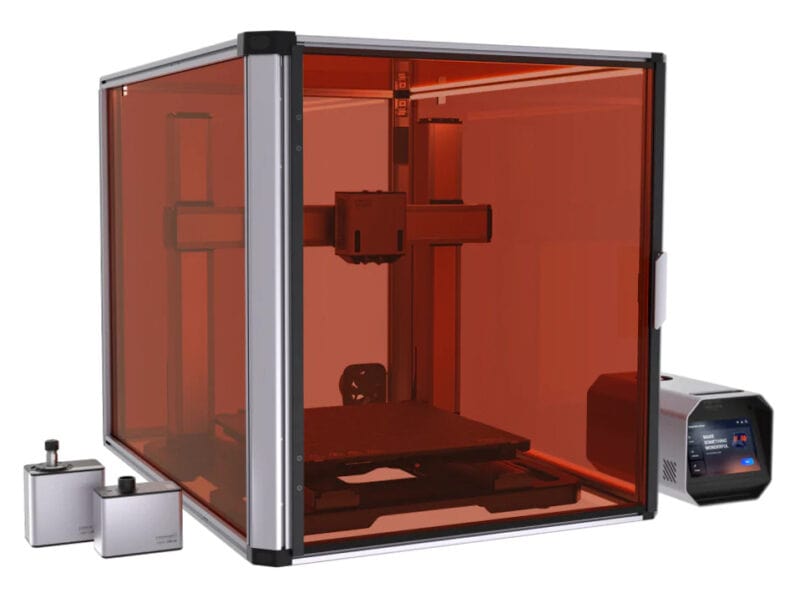
The Snapmaker Artisan is the latest and the best 3-in-1 3D printer from the Snapmaker team. It improves vastly upon the Snapmaker 2.0 and comes with an excellent set of features to deliver the best prototyping experience for its users.
Its giant build volume of 400 x 400 x 400 mm is enough to classify it as a large 3D printer and lets you 3D print a full-face helmet in a single piece with ease.
It also features a dual-extrusion 3D printer tool head with easily swappable nozzles and hot ends. This improvement over the Snapmaker 2.0 gives you the ability to 3D print with multiple colors and materials at once, as well as use soluble supports for complex geometries.
The maximum hot end temperature of the Artisan is also bumped up to 300 °C, giving you access to a slightly wider range of 3D printing filaments.
The laser engraver features a 10W high-power laser by default, which lets you engrave at faster speeds and on more materials. Its 0.2 mm precision remains unaltered, and you can still engrave fine details without losing quality.
Additionally, there’s a 200W CNC mill with a maximum spindle speed of 18,000 RPM, giving you a feed rate of 3000 mm/min. Whether it is sufficient to machine metals is something that remains to be seen, but it is a definite improvement over the Snapmaker 2.0.
To aid user experience, the Artisan now comes with a 7-inch touchscreen that is housed in the same space as the rest of the machine’s electronics. This design gives it a cleaner look and lets you easily separate the electronics from the device’s hardware.
The Snapmaker Artisan 3D printer is yet to be released worldwide and is only available for pre-order. With its quality features and demanding price tag, it is a 3-in-1 3D printer that is more aligned for enthusiast DIYers, as well as users with professional and industrial use cases.
Standout Features
- 300 °C dual extrusion 3D printing
- 10W laser module
- Large work area
- Industrial grade built quality
Technical Details |
|
|---|---|
| 3D printing build volume | 400 x 400 x 400 mm (Single nozzle) 350 x 400 x 400 mm (Dual Nozzle) |
| Laser engraving area | 400 x 400 mm |
| CNC carving area | 400 x 400 mm |
| Max nozzle temperature | 300 °C |
| Laser power | 10W |
| CNC spindle speed | 18,000 RPM |
| Supported materials | PLA, ABS, ASA, PETG, PVA, HIPS, Nylon, Carbon Fiber sheets, Hardwood (Beech, Walnut), Softwood, HDF, MDF, Plywood, Basswood, Paulownia, Pinewood, etc. |
| Connectivity | Wi-Fi, USB cable, USB flash drive |
| Supported OS | Windows, macOS, Linux |
What We Like
- Included laser proof enclosure
- Big 7-inch touchscreen with simple UI
- Multi-material 3D printing
- Dual-side 3D printing surfaces
Could Be Better
- Only available as preorder
- Takes up a lot of space
As a more tiny and compact machine, the EcubMaker 4-in-1 3D printer has no rival in its category. And while it resembles the Original Snapmaker, the EcubMaker stands out with its excellent build quality, rugged design, and a small LED light at the top.
The 3D printer comes fully assembled right out of the box, and you get four separate modules with the machine. The extra fourth module is a Y-style hot end for multi-color 3D printing with the EcubMaker. A pretty cool addition that’s not found on any other machines on this list.
To help you save time, the tool heads on the EcubMaker are easy to switch and are held in place with a single screw. This is a convenient solution for quickly switching between 3D printing, CNC milling, and laser engraving.
The EcubMaker TOYDIY 4-in-1 3D printer also has a flexible magnetic bed. Simply remove and bend it after 3D printing, and the model will pop right off.
You also receive a basic CNC engraving base plate and holding clamps along with several necessary tools you’d need to carry out CNC machining on the EcubMaker.
The knob-control LCD screen controller, lack of an enclosure, and a small working area are some of its notable downsides. But all of its features at a budget price more than compensate for this.
The EcubMaker 3D printer is a well-built machine suitable for first-time users, beginners, and professionals who need a budget machine for their rapid prototyping needs. It also makes a great learning tool for students in schools and colleges.
Standout Features
- Flexible magnetic printing bed
- Industrial linear guide rails
- Fully-assembled package
Technical Details |
|
|---|---|
| 3D printing build volume | 180 x 180 x 180 mm |
| Laser engraving area | 180 x 180 mm |
| CNC carving area | 180 x 180 mm |
| Max nozzle temperature | 220 °C |
| Laser power | 1.5W |
| CNC spindle speed | 14,500 RPM |
| Supported materials | PLA, Wood, Plastic, Acrylic, PCB, Plexiglass |
| Connectivity | SD card |
| Supported OS | Windows |
What We Like
- Automatic bed leveling
- Compact form factor
- Dual-color 3D printing
- LED light for illumination
Could Be Better
- Tiny work area
- Limited material support for 3D printing
- No enclosure
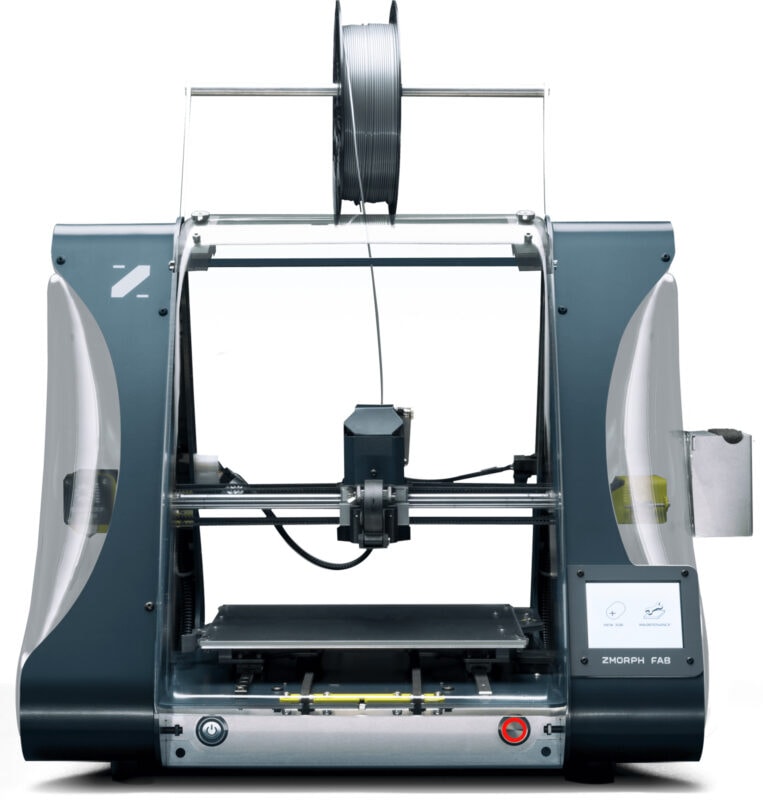
As a premium all-in-one machine, the ZMorph Fab barely has any other competitors in this category. It’s a complete machine designed for the entire rapid prototyping workflow.
At first glance, its fully-enclosed design and aluminum panels all over give you an accurate representation of its industrial build quality. The ZMorph Fab is built like a tank and uses high-quality components to ensure structural rigidity and stability while milling the most challenging materials.
It’s designed for complete autonomy, and all its features are centered around ease of use. Its automatic bed leveling, auto-tool detection, and calibration make it a true plug-and-play machine.
A closed-loop stepper motor system ensures high repeatability and reduces the chances of any missed steps. Compared to open-loop systems, this results in much smoother and more precise motion, especially when milling at high speeds.
ZMorph comes with its Voxelizer software and features a standardized CAM workflow, easy tool change, and path visualization while doubling up as a slicer for 3D printing. A HEPA-carbon air filter is built into the machine, preventing 3D printer fumes, laser smoke, and CNC debris from escaping your work area.
Out of the box, the machine functions as a single extrusion 3D printer and a CNC machine. However, ZMorph has multiple tool heads which let you carry out laser engraving and dual extrusion/multi-material 3D printing on the machine.
Its steep price might seem high for many users. But, considering its range of features and the high quality it delivers, the ZMorph Fab can be an excellent choice for professional prototyping purposes.
Standout Features
- Dual extrusion 3D printing
- Smart tool heads
- Fully-enclosed design
- Silent stepper drivers
Technical Details |
|
|---|---|
| 3D printing build volume | 235 x 250 x 165 mm |
| Laser engraving area | 235 x 250 mm |
| CNC carving area | 235 x 250 x 85 mm |
| Max nozzle temperature | 250 °C |
| Laser power | 2.8W |
| CNC spindle speed | N/A |
| Supported materials | PLA, ABS, PET, Nylon, PVA, HIPS, BS, Nylon, HDPE, PTFE, PC, PP, POM, PMMA. |
| Connectivity | USB, Ethernet, SD card |
| Supported OS | Windows, macOS, Linux |
What We Like
- Robust build quality
- Included air-filter
- Easy-to-use Voxelizer software
- Excellent print quality
- Upgradeable modular tool heads
Could Be Better
- Laser tool head is aftermarket accessory
- Motion driveways are exposed to dust in the enclosure
- High price
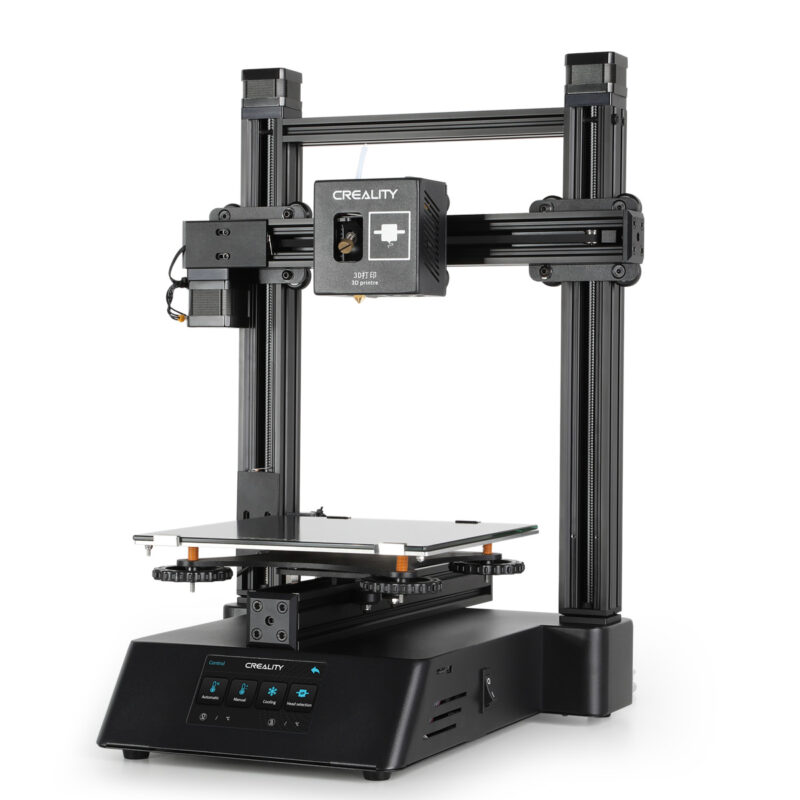
Creality’s well-known for its budget-oriented 3D printers, and the CP-01 is no exception. It is positioned as a budget alternative to the expensive Snapmaker 2.0 and is ideal for beginners on a budget looking for their first 3-in-1 3D printer.
The CP-01 comes in a medium form factor, featuring a modest 200 x 200 mm work area in all three modes. You receive three interchangeable modules, one for each function. You can easily swap them with the help of four screws to switch between the various manufacturing modes.
As a 3D printer, the CP-01 supports materials up to 280 °C and has a heated and textured glass print bed. The printer supports basic materials such as PLA, ABS, PETG, and PVA; however, you can feel the lack of an automatic bed leveling system in the printer.
For the laser engraving module, the CP-01 has a sub-0.5W laser , which is adequate for engraving on paper, cardboard, and plastic. Because its power is super limited, you can’t laser engrave on much else, let alone do any laser cutting.
Lastly, as a CNC machine, there’s a tungsten alloy CNC cutter in the box that you can use with the CNC tool head with a maximum spindle speed of 4800 RPM. Again, it’s not the most powerful, but it is able to take on light materials, like soft woods and plastics.
One of the biggest limitations is that there is no single software to prepare files for 3D printing, CNC milling, or laser cutting. As a result, you will have to use multiple programs. Not only is this more difficult to learn, but it can also be a hassle during operation.
You will also find that the open lead screws and belt drives will accumulate dust and debris over time. If you don’t put additional time into keeping them clean, this can lead to issues with your 3D prints, engravings, and milling projects.
For approximately $600, however, the CP-01 is a decent 3-in-1 3D printer from Creality that can serve as a budget prototyping machine for a variety of small projects.
Standout Features
- Modular design and assembly
- Full aluminum frame
- High-power stepper motors
Technical Details |
|
|---|---|
| 3D printing build volume | 200 x 200 x 200 mm |
| Laser engraving area | 200 x 200 mm |
| CNC carving area | 200 x 200 mm |
| Max nozzle temperature | 280 °C |
| Laser power | Less than 0.5W |
| CNC spindle speed | 4,800 RPM |
| Supported materials | PLA, ABS, TPU, wood, plastic, paper, PCB |
| Connectivity | USB cable and MicroSD card |
| Supported OS | Windows, macOS, Linux |
What We Like
- Affordable
- Quick-swappable modules
- Easy-to-use UI
- Fast assembly
Could Be Better
- No all-in-one software
- Extremely slow laser cutter
- Underpowered CNC milling cutter
What to Look for When Buying a 3-in-1 3D Printer
Compromises
No machine on the list is a perfect 3-in-1 3D printer, and each has some drawbacks. It’s crucial to consider the compromises that you’re willing to make when buying an all-in-one 3D printer.
For example, the lead screws on the Snapmaker 2.0 are great for machining, as they provide a lot of torque. However, this comes at the cost of slower speeds, which is not ideal for 3D printing.
Similarly, the Creality CP-01 is available at a lower cost than any other 3D printer but lacks good software and has an inferior build quality. On the other hand, the EcubMaker 3D printer comes with many features at a low price point. But it has a tiny work area, limiting you from working on large projects.
The two top 3-in-1 3D printers on the list, the Snapmaker Artisan and the ZMorph Fab, have some of the best functions for a multi-purpose machine. But, their high price and large form factor make them an impractical solution for those who need a budget 3-in-1 3D printer for small projects.
It is important to look at the various parameters of these machines and choose the most important ones for your needs. Doing so will ensure you get the best 3-in-1 3D printer within your budget and the one that best matches your needs.
Material Compatibility
Material compatibility is crucial in determining the applications for which you can use 3-in-1 3D printers. The more materials you can work with, the more options you have to solve your engineering problems and fully express your creativity.
For 3D printing, the three most popular materials are PLA, ABS, and PETG. All the 3D printers mentioned in this list are capable of printing these materials without any hiccups. The Snapmaker Artisan 3D printer, however, takes the lead with its high-temperature hot end (300 °C), letting you print with more advanced engineering plastics.
For CNC milling and laser engraving purposes, you must consider the power of the spindle or laser. Basic materials such as paper, wood, MDF, plexiglass, and leather can usually be worked with on basic machines. But if you want to work with metals or other tougher materials, you’ll need to make sure that the machine has enough power and is rigid enough (in the case of CNC cutting).
Laser Type and Power
A semiconductor laser engraver is the most suitable type of laser for a 3-in-1 3D printer. They’re compact, portable, easy to operate, and compatible with various materials. With lasers, the higher the laser power, the better its cutting and engraving performance. A high-power laser will also have faster working speeds and reduce your work times significantly.
Creality’s CP-01 uses the lowest powered laser engraver with a power rating of 0.5W. This will limit your engraving and cutting capabilities, and you’ll need to laser engrave at extremely slow speeds to get good-quality results.
With the Snapmaker 2.0 A350T and EcubMaker, you get a 1.6W laser that is adequate for most basic purposes and delivers an acceptable working speed. The ZMorph’s 2.8W laser engraver, too, is powerful for laser engraving but might fall short for high-depth laser cuts.
The Snapmaker Artisan 3D printer with its 10W laser is the best laser engraving machine in the list and delivers high engraving speeds of up to 6000 mm/min. Snapmaker claims this speed is almost 8 times that of a 1.6W laser engraver, letting you create terrific workpieces instantly.
Snapmaker 2.0 A350T does allow you to upgrade to a 10W laser engraver without buying a separate machine altogether. This choice makes the most sense if you’re on a budget and still need a high-power laser engraver in your 3-in-1 device.
It is often also possible to tinker with your machine and install a third-party laser module with a higher power rating. This might void your warranty, however, and could be dangerous if not done correctly.
Software Compatibility
Running multiple processes on a single machine is a challenging task. A good piece of software will help you to achieve a smooth workflow by bundling up all the different functions in a single place.
For example, Snapmaker’s Luban combines all the functions you’d need for 3D printing, CNC carving, and laser engraving in a single place. You can switch between different modes, access various features, and prepare your files for machining, all within a single software.
Similarly, the Zmorph Fab comes with its Voxelizer software, and the EcubMaker has its Ecubware. Both are designed as companion software for their machines and complement their hardware very well.
But, Creality’s CP-01 3D printer is an exception and comes with no single software. You’ll need different software for each process, making it challenging to prepare the files.
Therefore, you’d be better off with a Snapmaker 2.0 A350T or the EcubMaker 3-in-1 3D printer. These machines have well-designed software that goes along with them and will give you a better overall experience.
Accessories and Add-ons
Accessories and add-on modules extend your printer’s capabilities and let you fine-tune the machine as per your needs. Especially with a CNC machine and laser engraver functionalities, aftermarket accessories will help you with specific applications on your 3-in-1 3D printer.
The Snapmaker 2.0 comes with a host of accessories and add-ons such as the rotary module, 10W laser tool, power modules, linear rails, and air filters. In the box, too, you get a bunch of accessories and tools that enhance the user experience with the machine. This compatibility ensures that you can fully customize the printer to your workflow, and get the best value.
Likewise, the ZMorph Fab has up to five different tool heads that you can purchase as aftermarket accessories. These let you use multi-material 3D printing and laser engraving on the printer.
Ease of Switching
Another crucial yet overlooked factor to consider while buying a 3-in-1 3D printer is the ease of switching into different modes. An easy-to-switch mechanism that takes less time to shift between modes will deliver a smooth workflow experience.
To ensure a seamless 3-in-1 experience, all the machines in this list have some degree of modular design. You get separate, easy-to-switch modules and components for each process.
With the Snapmaker 2.0 A350T, Creality’s CP-01, and the EcubMaker, you get small, interchangeable tool heads. These are held onto the machine via a slide-n-screw mechanism. Switching the tool heads and preparing the machine for the following process usually takes a few minutes.
The machining beds can be more difficult to swap out. Since they need to withstand high forces for CNC machining and need to be mounted as flat as possible, they are sometimes fastened with a lot of bolts. Removing these to swap out the bed can take some time.
Enclosure Options
3D printing, CNC milling, and laser engraving emit harmful fumes, dust, and dirt during machining. While an enclosure is not strictly necessary, it helps to separate the working area from the surroundings. It also helps to keep all the waste material within a contained area.
Especially if you’re planning to use it as a CNC machine, an enclosed chamber will keep all the swarf inside and reduce your cleaning efforts. Likewise, when you burn materials using a laser cutter, an enclosure gives you the option to funnel off any smoke with a fan and exhaust hose.
For 3D printing, an enclosure can be useful for keeping the print temperature consistent. This is especially important when you’re printing with ABS filament, which has a higher chance of warping if the temperature fluctuates.
For this reason, you can find many aftermarket 3D printer enclosures, as well as enclosed 3D printers. When buying a 3-in-1 3D printer, however, you’ll have to check whether you want an enclosure and whether it comes included or separately.
The ZMorph Fab 3D printer considers all of this and comes in a neatly enclosed chamber with an air filter. The enclosure does not take up additional space on your desktop and is built around the frame of the printer itself. The Snapmaker Artisan, too, comes with an enclosure; however, it occupies significantly more desktop space than the Zmorph.
With the Snapmaker 2.0, you can purchase a separate enclosure. As for the other 3-in-1 3D printers on the list, you’d have to either create a DIY enclosure or use some makeshift solution for enclosing the machines.
Can I Turn My 3D Printer Into a Laser Cutter?
You can convert a 3D printer into a laser engraver or cutter by installing a laser engraving module on the print head carriage. The ones sold by 3D printer manufacturers as add-ons are often only powerful enough for laser engraving. For laser cutting, you will need a high-powered laser module that can output 2 Watts or more.
Also, keep in mind that the design of a 3D printer is not ideal for laser cutting. The build volume is often too small, and the print bed needs to be protected from the laser beam.
Since 3D printers, CNC machines, and laser engravers all work on the same principle, namely computer-controlled machining, it’s theoretically possible to convert a 3D printer into any of these machines. However, it is often more practical and economical to buy a machine that’s specifically designed for the task you want to do.
With enough effort, however, you can even turn a 3D printer into a hot wire cutter,
What Does a 3-in-1 3D Printer Do?
A 3-in-1 3D printer is a combination of 3D printer / laser engraver / CNC cutter. As such, you can use it for 3D printing, CNC carving or CNC machining, and laser engraving. You won’t be able to do this all at once, but you can switch between the three functions by changing the tool head and/or the machining bed.
Are 3-in-1 3D Printers Any Good?
There are decent 3-in-1 3D printers out there, like the Snapmaker. The reality, however, is that any 3D printer / laser engraver / CNC cutter machine comes with a number of compromises. If you want the best results for each type of manufacturing, you are always best off getting three separate machines.
Can a 3D Printer Be Used as a CNC?
You could use a 3D printer as a CNC milling machine if you replace the print head with a CNC cutter. The design of 3D printers does not lend itself to CNC machining, however, so you won’t get great results.
The belt-driven axes of a 3D printer are not capable of dealing with the forces generated by the CNC mill, and the print bed is also not designed to withstand CNC machining forces.
Conclusion
3-in-1 3D printers are excellent for hobbyists, shops, and industries with limited working space. You get the benefits of all the machining processes in a single package, often at a much lower price. That said, you need to consider the software, accessories, and material compatibility before you make the decision.
The Snapmaker 2.0 is our pick for the best overall 3-in-1 3D printer you can buy. It has a great track record, comes with an excellent set of features, and features several add-on accessories. At its current price, it gives you the best value 3D printer / laser engraver / CNC milling machine combination there is right now.
Alternatively, the ZMorph Fab and the EcubMaker are two other great 3-in-1 3D printers. The ZMorph is the best in the high-end category and suited for professional applications. In contrast, the EcubMaker is the best budget all-in-one 3D printer. Both machines have a solid build quality and rich features for their price and will give you a superb machining experience.
What are your thoughts on an all-in-one 3D printer? Do you think it’s better to get a multi-purpose machine or use separate devices for each process? Let us know in the comments below.
